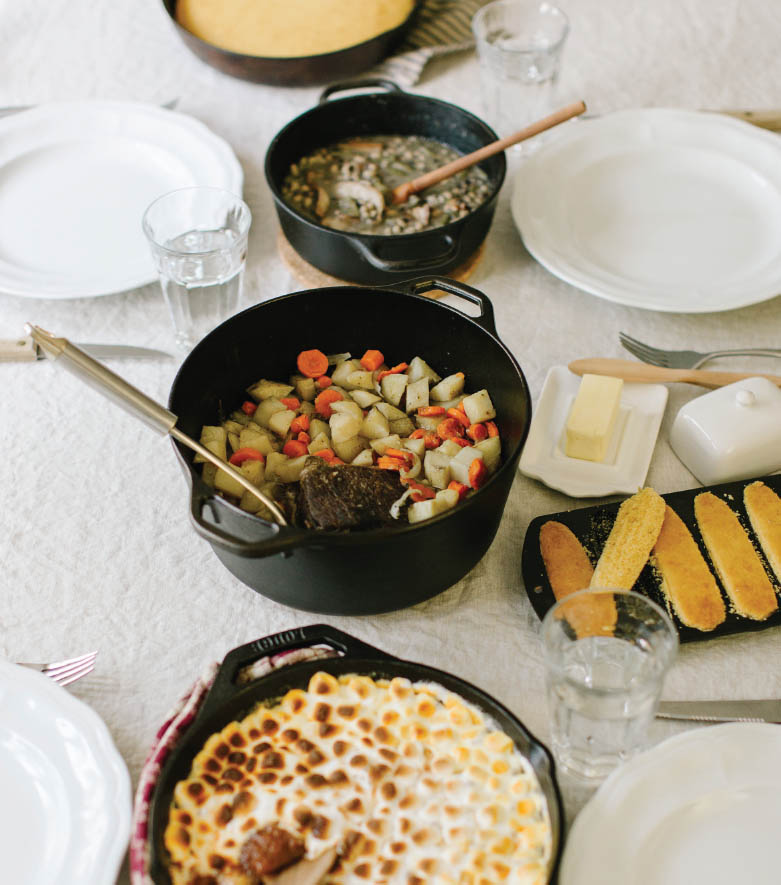
ALWAYS REMEMBER:
GONE WITH THE LARD ISN’T THE END OF FLAVOR
Lodge Manufacturing Company
In the mid-1970s, my father, R. Norwood Kelly Jr., was diagnosed with diabetes. Overnight, my parents switched the family’s home-cooked meals from traditional Southern cuisine to an updated version.
Along with a jar of bacon drippings for seasoning, deep-fried foods were gone with the lard. Cornbread, long a fixture on our family’s table, was out of favor, and whole-wheat dinner rolls became a welcomed replacement. Olive oil, garlic, sodium-free salt, and other ingredients became the norm rather than foreign elements.
Initially, my two brothers and I wrinkled our noses at the concepts. In time, we learned to enjoy a more flavorful and broader variety of home-cooked recipes than those in the past (not that we didn’t slip out to restaurants in Savannah, Georgia, to savor fried chicken and barbecue from time to time).
I won’t say that the change in dietary selections was ahead of its time; it was, however, a necessity we embraced for the benefit of my father and our family. Leading the charge in our conversation were cast-iron skillets, griddles, Dutch ovens, and bakeware lovingly handed down from previous generations.
That’s why I’m excited about Ashley L. Jones’s new book—Modern Cast Iron: The Complete Guide to Selecting, Seasoning, Cooking, and More. Ashley’s is a much-needed work for beginners and experienced cast-iron cooks. Many of the recipes are updated classics, with Ashley lending her experience and application of ingredients to craft healthier and more enjoyable results.
As difficult as it may be for some readers to accept the concepts presented in this guidebook, I’ve learned through the years that culinary exploration pays off in new and unexpected heights of satisfaction. And what better cookware to accompany cooks through their exploration than cast iron? With a history that dates to the Middle Ages, cast iron provides cooks with a tool to utilize every cooking technique—searing, baking, stir-frying, sautéing, braising, deep frying, broiling, and stewing—for generations of wonderful results.
Along with allowing the use of multiple cooking techniques, cast iron doesn’t require as much oil as other forms of cookware. In many instances, cast iron is the go-to item for fat-free cooking—a feature chefs and home cooks employ as an assist for folks watching their waistlines and calories. And, lest we forget, cast iron is equally at home on the stove top, in the oven, on the grill, and over a campfire with a price point consumers find appealing to their pocketbooks.
One of Ashley’s more intriguing substitutions for fried chicken is oven-baked coconut chicken. After the first bite, you’ll wonder where this recipe’s been all of your life. Dessert is another area where family history maintains traditional ingredients in recipes, with: “If Mama used them, why shouldn’t we?” a familiar declaration. Ashley crafts a winner with a blueberry cobbler featuring gluten-free flour and honey that is a tasty update on a classic. And a delightful apple crisp is another twist on conventional kitchen wisdom.
Seasoning and maintaining cast-iron cookware is a topic that’s been discussed throughout the centuries of its use. Every brand on the market offers preseasoned items, though some consumers prefer to burn off manufacturers’ seasoning and begin the process anew. To assist readers, Ashley L. Jones reviews the use and care of cast-iron cookware with easy-to-follow instructions.
Regardless of the origin of your cast iron’s seasoning, the best way to improve the easy-release (nonstick) aspect is to cook, cook, cook, and cook with every item in your collection. Anything prepared with cast iron—protein, vegetable, starch, and sugar emit oil onto the cookware. Heat from cooking turns oils into carbon particles, and each use adds more carbon, enhancing seasoning.
Cast-iron cookware evokes memories of home-cooked meals prepared for every occasion. Other memories recall campfire cooking with scout troops, or fishing and hunting adventures. And many become teary-eyed at the recollection of a grandparent standing beside them as they prepared their first batch of scrambled eggs.
My family’s transition from classic Southern cuisine didn’t end our love of traditional recipes. It opened the door to more extensive and wholesome selections we continue to embrace. And we share the meals and memories we learned years ago with the children and grandchildren who will inherit our cast-iron cookware and pass them on to the generations that will follow.